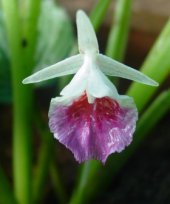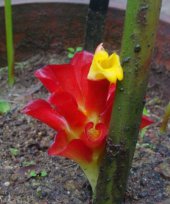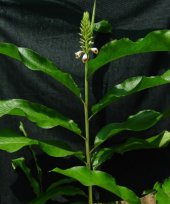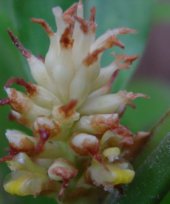The ornamental Gingers are having beautiful, sweat scented flowers and are of great commercial values. They are wonderful group of plants related to edible gingers. There are mainly two types gingers based on their growth habit. They are the evergreen and non-evergreen groups. The former can be grown outdoors in summer and as houseplants in winter and the later varieties need a winter dormancy period when they are stored cool (but not cold) and dry to wait for the next growing season. There are varieties for sun, shade and in-between. Some varieties of ginger have fragrant flowers and others have spicy foliage. The Hedychiums (butterfly gingers) and some species of Costus are the most fragrant types of ginger. Good flowering requires proper sunlight. The varieties that prefer shadier conditions tend to perform best indoors. Varieties of ginger that need less sun are the Globbas (known as dancing ladies) and the Kaempferias (peacock gingers). Other similar plants are the Alpinias. They are known as bamboo gingers and they have lovely foliage and like both light and filtered shade.
ALPINIA - SHELL GINGER : Alpinias are the largest genus in the ginger family with 250 species ranging from 5’ to 10’ as a general rule. This group of plants has major landscape value due to the different forms, varying heights, and their tropical foliage. Flowers are brightly and beautifully coloured. Some species are decorative for its variegated foliage ie A. Sandurae.
COSTUS - SPIRAL GINGERS : They are called spiral gingers because of their spirally arranged leaves. They are very diverse group of gingers, from sun lovers to shade lovers, ranging in height from 3’ to 8’. They produce crepey flowers out of terminal cones while others produce plastic-looking tubes out of terminal cones. The cones are very attractive even after they have finished blooming. Flowers are non-fragrant, but long lasting.
CURCUMAS - HIDDEN GINGERS : Curcumas are valuable ornamentals for their beautiful spikes and their foliage that resembles banana plants. The spikes producing basally or from the central part of the plant. Some of the Spring blooming curcumas are very beautiful for they flower before their foliage has a chance to come up and hide them, hence the name “hidden ginger”. Curcumas that bloom out of the top are being used extensively in the cut flower industry. Plant them with protection from the hot, afternoon, summer sun. This plant goes dormant with a week of consistent night temperatures of 40 degrees.
GLOBBA - DANCING LADIES : The Globbas are Small plants that reach 12” to 24”are shade lowers. They prefer to grow shady areas and produce beautiful brightly coloured flowers, which looks similar to a dancing girl Globbas require morning sun or filtered sun, no direct sun as the leaves will burn. Well-drained soil, keeps the rhizomes from rotting in the winter while they are dormant.
HEDYCHIUM - BUTTERFLY GINGERS : This gingers are the most beautiful sweat scented gingers in the family Zingiberaceae the individual flowers resemble butterflies. This group reaches a height of 6-8’ in medium sun and 4’ in full sun. India is the center of origin of this group with maximum number of species diversity in the North- Eastern India. Hedychium coronarium, is widely cultivated, H. flavescens, H. greenii, H. rubrum, H. coccineum, H. wardii, H. elwesii etc are some of the beautiful butterfly gingers.
KAEMPFERIA - PEACOCK GINGER : They are also shade-loving plants. They are having, beautifully zoned patterns with silvers, blues, blacks, and shades of green make this plant very effective even without flowers. Iridescent purple flowers are produced over the top of the plants. If this plant receives too much sun, the leaves will curl up in defense of the hot rays, so plant in those dark shady places.
ZINGIBER - EDIBLE GINGERS : This is the group of the common edible gingerZingibers have two types of growth habits: 1) erect with 1” narrow leaves and 2) the others have arching stems with dark, glossy, green leaves. Most Zingibers produce basal inflorescence (from the ground) mid to late summer, and contain a gel that is very fragrant and used in shampoo blends; hence the name of shampoo ginger. Rhizomes can rot in winter when dormant with the cold wet soil not especially well drained. Exposure: medium sun to afternoon shade.
| |
|

Alpenia sanderae
|

Alpnia zerumbet
|

Curcuma roscoeana
|

C. ecalcarata
|
|

Etlingera elaiter
|

Etlingera elaiter
|

Globba schomburkii
|

Hedychium .coccineum
|
|

H. coronarium
|

H. flavescens
|

H. stenopetalum
|

H. thyrsiforme
|
|

Hitchenia careyana
|

Zingiber ottensii
|
|
|
Propagation
The propagation of gingers is very easy. Most of the species are propagated vegetatively by division of the rhizome and cuttings of the aerial shoot. In many species, the seed setting is common. In such species seeds can also be used for propagation. Bulbils/which are produced abundantly on the inflorescence and stem are also used for cultivation. In A. purpurata the bulbils develop into seedlings before they are shed. Selection of fully mature seed rhizome free from disease is an important Division is done by cutting and separating rhizomes into pieces containing two or more buds. Clumps can also be divided into smaller clumps or into individual plants. A portion of rhizome with atleast one old and one young aerial shoot constitutes a planting unit. Newly divided plants should be kept out of direct sun for a week or two. Cuttings of aerial shoots may also be used in Costus, Globba and Hedychium.
Seeds also form an important planting material in the species of Alpinia, Curcuma, Hedychium, Costiis etc. Mature seed capsules are to be selected from healthy plants. Immediately after collection, the husk is removed and the seeds are to be washed repeatedly in water for removing the mucilagenous coating. Then the seeds must be mixed with wood ash and dried in shade for a day. Inorder to ensure uniform and early germination seeds should be grown immediately after extraction.
Healthy seed-rhizome is an essential prerequisite for proper growth of many gingers. Since there is a gap of four to five months from the time of harvest (November) to the time of next sowing season (April-May), it is necessary to preserve the seed rhizome in good condition during this period. Excess moisture may cause damage to the rhizome. All ginger plants grow best in wet humid conditions. So in garden, it is better to grow them in well-drained soil. During summer, if the plants are not properly sprayed, their aerial shoot show permanent wilting.
The best method of planting gingers is by placing the plant at soil level and covering the rhizome and roots with a mixture of loam or garden soil, sand and compost. The compost is used as a soil conditioner, moisture retainer and as a slow-release fertilizer. Most species can be grown by this method. The plants with resting fleshy rhizome (Curcuma spp., Zingiber spp., etc.) can be grown on a special bedding of 10-30 cm height. This can be prepared using a mixture of garden soil, sand and compost. The compost must be replaced 3-4 times a year.
The growing medium of ginger plants must not be allowed to dry out. To keep the soil cool and moist, a mulch of dead leaves is placed around the base of the leaf-shoots. Only dead leaves are used for mulching, as fresh leaves generate too much heat, which will destroy the rhizome.
Pests and Diseases
Most of the gingers are relatively pest and disease free. In many species of Hedychium, Globba etc. leaf-roller catterpillars of small moths may eat up the leaves while hiding, rolled up in a tube of the leaf blade. Tiny larvae of leaf-minors cause some damage to the leaves. The minute black insects, the thrips, deform and stunt leaf and flower growth by their feeding activity. Grass hoppers may also cause damage to the leaves by feeding on them. Sucking stinkbugs may introduce virus and bacteria during feeding. The most serious pest, seems to be the white mealy bugs and scale insects. They cause serious damage to the young shoots and leaves due to their attack. These insects can be controlled by spraymg with a general common and safe insecticide like Malathion.
The garden gingers, to some extent, are resistant to the diseases caused by viruses, bacteria and fungi. But the diseases are more common among the commercially important spice gingers such as Curcuma longa, Elettaria cardamomum and Zingiber officinale.
The most common disease of garden gingers include the soft rot or rhizome rot caused by Pythium aphanidermatum. The disease is soil borne and the fungus multiplies with build up of soil moisture with the onset of south west monsoon. Younger sprouts are more suscpetible to diseases. It is the most destructive disease/which results in total loss of affected clumps. Careful removal of the affected clumps and drenching the affected area with fungicides (Dithane M-45, 0.3%) would check the spread of the disease.
Another seed and soil borne disease is bacterial wilt caused by Pseudomonas solanacearum. The water soaked spots appear at the collar regions of the pseudostem and progress upwards and downwards. In the advanced stage the plants exhibit severe yellowing and wilting symptoms. A uniform drenching with bordeaux mixture or 0.2% copper oxychloride is found effective.
Leaf spot is another fungal disease, caused by Phyllosticta zingiberi, noticed on leaves during July to October. Disease starts as water soaked spots and later turns as whitish spot surrounded by dark brown margin and a yellowish halo. This can be controlled by spraying 1% Bordeaux mixture or 0.2% Dithane M-45.
The mosaic or marble disease is another disease caused by a virus. It spread through aphid vector Pentalonia nigroneruosa and also by the use of infected planting material. The infected young leaves develop spindle-shaped slender chlorotic flecks measuring 2-5 mm in length. All the subsequently emerging new leaves show characteristic mosaic symptoms with chlorotic and green stripes. Infected plants continue to survive for many years and serve as sources of inoculum. Use of healthy and disease free rhizomes for planting and destruction of diseased clumps by burning are two effective methods of control.


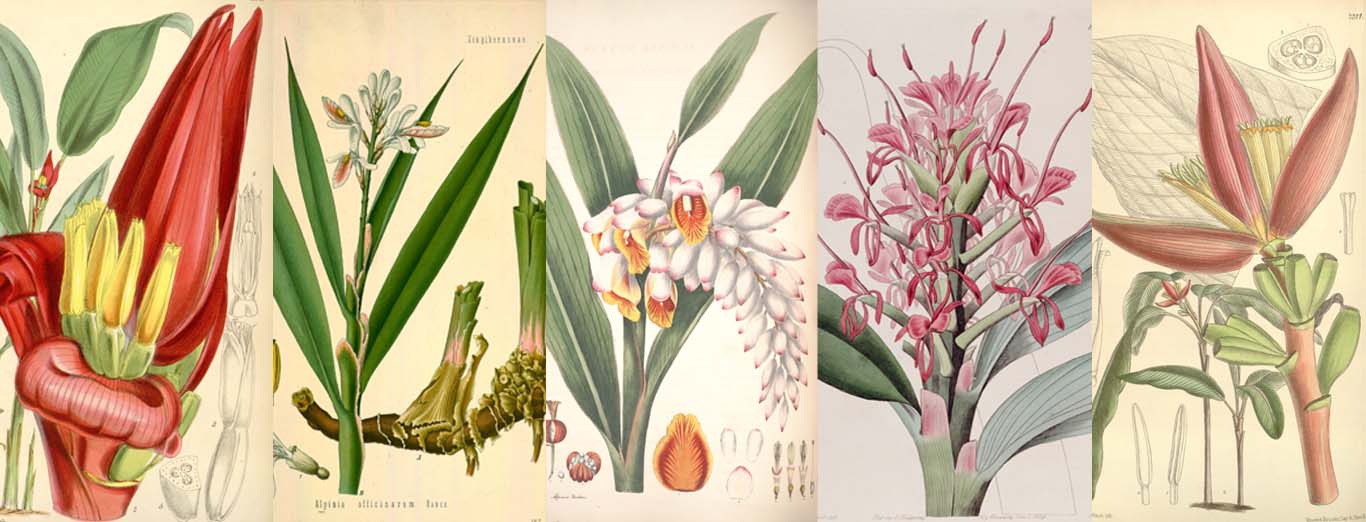















 News & Events
News & Events

